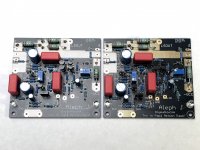Finally, after 7 weeks of waiting, I have the original Toshiba JFets from punkydawgs (3 weeks over the ocean and 4 weeks in the local customs and post).
Punkydawgs kindly included these caps in the shipment. These caps loosly fit a pair of jfets, only I am not sure what would be a reason to use these. Some sort of shielding? Could some wise men give an advise?
Now, I will be able to continue working on my AJ problems with excess distortion and noise. I did try to put BC556 instead of LSJ74 to see how it goes, and was able to set zero offset on the output and much lower hum/hiss. I even measured the THD (with BC556) at 1W on 8 ohm and got it about 0.10% (what agrees with the simulation). So, LSJ74 are very much a probable cause of the problems. Will try to change them now.
But these newly received 2SJ74 will finally go to the AJZen boards - was waiting so long to built it already 🙂 Hopefully, my original board of AJ will not fry them while testing - as I did not understand what could happen with my initial LSJ74 - they worked fine on my first measurement but developed bad distortion soon after...
Punkydawgs kindly included these caps in the shipment. These caps loosly fit a pair of jfets, only I am not sure what would be a reason to use these. Some sort of shielding? Could some wise men give an advise?
Now, I will be able to continue working on my AJ problems with excess distortion and noise. I did try to put BC556 instead of LSJ74 to see how it goes, and was able to set zero offset on the output and much lower hum/hiss. I even measured the THD (with BC556) at 1W on 8 ohm and got it about 0.10% (what agrees with the simulation). So, LSJ74 are very much a probable cause of the problems. Will try to change them now.
But these newly received 2SJ74 will finally go to the AJZen boards - was waiting so long to built it already 🙂 Hopefully, my original board of AJ will not fry them while testing - as I did not understand what could happen with my initial LSJ74 - they worked fine on my first measurement but developed bad distortion soon after...
Attachments
Last edited:
@cubicincher, did you use some thermal paste around Jfets or something to keep this "heatsink" in place? Looks cool, but is it worth the trouble?
As Mighty ZM once said in this thread:
I trust him, with no reason somehow 😀
As Mighty ZM once said in this thread:
#6409no need
show me Papa's pcb with JFets hugging
I am obsessed, but even that less with years
I trust him, with no reason somehow 😀
to avitkauskas
I used a 2-component-adhesive which is used by the computer-freaks to mount
CPU-coolers on thre chips.
arctic silver thermal adhesive....
Cheers
Dirk
p.s.: you also can bend the two JFets together with some shrink tube -
but not really necesssary
I used a 2-component-adhesive which is used by the computer-freaks to mount
CPU-coolers on thre chips.
arctic silver thermal adhesive....
Cheers
Dirk

p.s.: you also can bend the two JFets together with some shrink tube -
but not really necesssary
Hi, I checked the wiring diagram of the Aleph j and I saw that the resistors n. 28 and n. 29 are 4k7 Ohm for green or red LEDs, but making a calculation the resistance should be 1k5 Ohm on 24V input ..?
My question is if I want to use a standard blue led with 15 mA of current and 3.00 V of voltage, do I always have to use a 4k7 Ohm resistor or according to 1K Ohm calculations.?
Thanks for your patience : D
My question is if I want to use a standard blue led with 15 mA of current and 3.00 V of voltage, do I always have to use a 4k7 Ohm resistor or according to 1K Ohm calculations.?
Thanks for your patience : D
That would be very, very bright. Even with an old LED.
A good rule of thumb with modern super bright LEDs is 1K per volt of PSU will give a brightness that will not be extremely bright.
In these projects I’m just using 15k as standard.
A good rule of thumb with modern super bright LEDs is 1K per volt of PSU will give a brightness that will not be extremely bright.
In these projects I’m just using 15k as standard.
In my experience, I ended up using 100k with the modern blue LEDs that I want to extend to the front panel, otherwise they are too bright 🙂
Finally, after 7 weeks of waiting, I have the original Toshiba JFets from punkydawgs (3 weeks over the ocean and 4 weeks in the local customs and post).
Punkydawgs kindly included these caps in the shipment. These caps loosly fit a pair of jfets, only I am not sure what would be a reason to use these. Some sort of shielding? Could some wise men give an advise?
Now, I will be able to continue working on my AJ problems with excess distortion and noise. I did try to put BC556 instead of LSJ74 to see how it goes, and was able to set zero offset on the output and much lower hum/hiss. I even measured the THD (with BC556) at 1W on 8 ohm and got it about 0.10% (what agrees with the simulation). So, LSJ74 are very much a probable cause of the problems. Will try to change them now.
But these newly received 2SJ74 will finally go to the AJZen boards - was waiting so long to built it already 🙂 Hopefully, my original board of AJ will not fry them while testing - as I did not understand what could happen with my initial LSJ74 - they worked fine on my first measurement but developed bad distortion soon after...
You could use this to keep them in place ...
Attachments
@tricksters, thanks for the reference to the heatsink plaster - good to know these things exist. I was usually using some heatshrink to keep transistors together.
Concerning your question about PSU capacitors and resistors - these are snubbers and are optional. In some of my amps I used these places on the PSU to put LEDs on the wires extended to the front panel (LED in the capacitor place) 🙂
Concerning your question about PSU capacitors and resistors - these are snubbers and are optional. In some of my amps I used these places on the PSU to put LEDs on the wires extended to the front panel (LED in the capacitor place) 🙂
1A6 to 1A7 is good for Iq
that across 0R27 is 430 to 460mV
are those 2W or 3W Sissies?
you have dissipation of those in rails ~ 0.8W, so better to use 3W
that across 0R27 is 430 to 460mV
are those 2W or 3W Sissies?
you have dissipation of those in rails ~ 0.8W, so better to use 3W
- Home
- Amplifiers
- Pass Labs
- Aleph J illustrated build guide
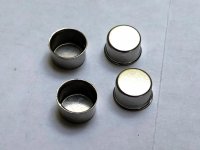
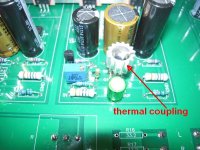
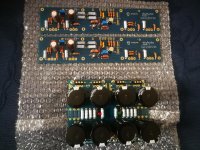
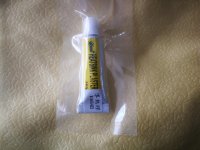
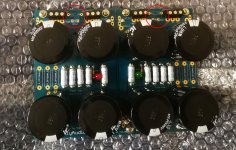
 Thank you
Thank you